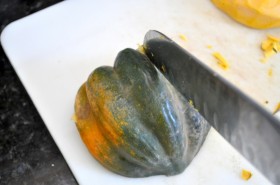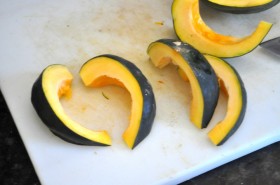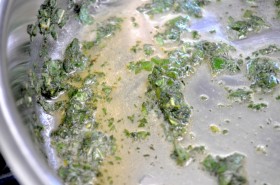This is part of the continuing series in which I alone have to deal with our CSA for a week, including planning, cooking, and eating. This is a recipe that I found to deal with the two acorn squash that I had been dealt by Red Fire Farm. We often stuff them, but I just didn’t feel like doing so. This recipe turned out to be a preferable alternative for me. It’s so tasty! And, after some real trial and error, once I learned how to peel these suckers, it wasn’t really difficult.
Acorn Squash with an Herbed Cider Glaze
Makes 3-4 servings
| Amount | Ingredient | Preparation | Notes |
|---|---|---|---|
| 2 | Acorn squash | Cut into chunks (see below) | You will need two medium to large acorn squash, or one of a larger variety, such as butternut |
| 2-3 TBsp | Unsalted butter | ||
| 1/4 cup | Fresh sage | Finely chopped | Dried sage will not impart nearly the same flavor |
| 2 TBsp | Fresh thyme | Finely chopped | Ditto on fresh thyme; don’t substitute dried |
| 1.5 cups | Cider | I used hard cider | |
| 1 cup | Water | ||
| 2 tsp | Sherry vinegar | ||
| A pinch | Kosher salt |
Directions
This is an extremely easy recipe except for one part:
Changing two of these…
… into this:
Luckily for you I tested of ways of tackling this trick task, one A LOT easier than the other!
- Remove the seeds from the square, peel it, and cut it into cubes. Easier said than done.
- Technique 1 (don’t bother, in fact, just skip to “Technique 2″. But, for the curious…): cut the squash in half from pole to pole. Use a large spoon to scoop the seeds out of each half and scrape the hole until you have clean flesh. Remove the stem by cutting a notch out around it. Then put the flat side on the cutting board, and using a sharp chef’s knife, peel the squash. Carefully work around the ridges, with the goal of removing as little of the flesh as possible and only removing the skin.
It helps to cut down the slopes of each ridge from the peak to the valley. It really helps to have patience and a steady hand. Once the half-squash is peeled, cut it in to wedges along its ridges, then chop the wedges into approximately one-inch cubes.
- Technique 2 (preferred): cut the squash in half from pole to pole. Use a large spoon to scoop the seeds out of each half and scrape the hole until you have clean flesh. Remove the stem by cutting a notch out around it. Then put the flat side on the cutting board. NOW cut it into wedges BEFORE peeling. Then peel each wedge with a vegetable peeler. Once the wedges are peeled, chop them into approximately one-inch cubes.
If you’re extraordinarily unlucky and have a squash that is so large and/or thick-skinned that the peeler won’t work, rever to technique #1.
- Technique 1 (don’t bother, in fact, just skip to “Technique 2″. But, for the curious…): cut the squash in half from pole to pole. Use a large spoon to scoop the seeds out of each half and scrape the hole until you have clean flesh. Remove the stem by cutting a notch out around it. Then put the flat side on the cutting board, and using a sharp chef’s knife, peel the squash. Carefully work around the ridges, with the goal of removing as little of the flesh as possible and only removing the skin.
- Chop the herbs and melt the butter in a large skillet (preferably one with a cover) over low heat. Once the butter has started to melt, add the herbs and cook, stirring, for about 5 minutes, until the butter starts to turn golden brown. Don’t be tempted into increasing the temperature to speed things up. This part needs to be taken slowly in order to not burn the butter or brown the herbs.
- Add the squash, the apple cider, the water, the sherry vinegar, and a generous pinch of kosher salt. Stir. It will start out as a very wet mixture, almost like a soup. Raise the heat to medium (6 out of 10) and bring it to a boil. You can speed this by covering it temporarily, if your pot has a cover.
Once you’ve reached a boil, remove the cover and find the level of heat that maintains a low boil. You want large bubbles, not just a simmer (small bubbles), but you want to maintain that boil on the lowest heat possible. Leaving the cover off is important because you need to moisture to evaporate out to reduce it to a glaze (I once made the mistake of leaving the cover on and wondering what was wrong).
Now you can set a timer for 5 minutes and walk away (but don’t go far). Keep checking on it every five minutes to make sure it’s not boiling over. After 30 minutes, it should be finished. The squash should be tender, and the liquid should be reduced to a glaze. My test is to run my wooden spoon across the botton of the pan to part the liquid. If it takes a few seconds to ooze back and cover the bottom, you’re done.
- Season with pepper and additional salt to taste (if necessary). Serve over rice.













